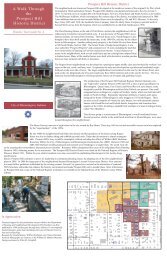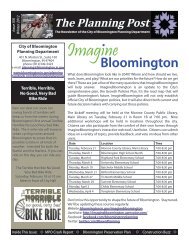Peak Oil Task Force Report - City of Bloomington - State of Indiana
Peak Oil Task Force Report - City of Bloomington - State of Indiana
Peak Oil Task Force Report - City of Bloomington - State of Indiana
You also want an ePaper? Increase the reach of your titles
YUMPU automatically turns print PDFs into web optimized ePapers that Google loves.
MITIGATION GOALS & STRATEGIES<br />
SHORTTERM STRATEGIES (15 years)<br />
1. Establish an emergency fuel reserve to prepare for a fuel shortage.<br />
The <strong>City</strong> should shift its practices to maintain an emergency reserve <strong>of</strong> fuel (beyond that<br />
which it already maintains for daily use) in the event <strong>of</strong> a shortage and/or drastic price<br />
increase.<br />
2. Establish a measurable goal for reducing total vehicle miles driven.<br />
Toward that end, the <strong>City</strong> should start tracking total miles driven on each vehicle.<br />
3. Encourage Team Process to develop a plan for a Model <strong>City</strong> Green Fleet.<br />
As the <strong>City</strong>’s Team Process examines and audits the current <strong>City</strong> fleet and prioritizes<br />
acquisition, it should do so with an eye to discerning which vehicles might be eliminated<br />
and how we might maximize fuel efficiency in the short term. In the long term, the <strong>City</strong><br />
should transition its fleet away from reliance on fossil fuels. Some ideas Team Process<br />
might pursue include: reducing the size <strong>of</strong> the <strong>City</strong> fleet through partnerships with car<br />
sharing groups (this might be a consortium <strong>of</strong> <strong>City</strong>, County, the schools, and IU) and<br />
requiring best‐in‐class purchases, with priority given to electric and plug‐in hybrid electric<br />
vehicles as appropriate<br />
4. Encourage use <strong>of</strong> more bicycles, Segways, motorized bikes, and electric cars<br />
in code enforcement, where feasible.<br />
5. Establish a <strong>City</strong> bicycle fleet<br />
Institute a <strong>City</strong> bicycle fleet so that <strong>City</strong> employees have the option to ride a <strong>City</strong> bicycle<br />
rather than drive a <strong>City</strong> vehicle. Currently, the <strong>City</strong>’s Parking Enforcement Division owns<br />
two bicycles for use by two <strong>of</strong> its nine enforcement <strong>of</strong>ficers. Each employee using such a<br />
program would likely have to have her/his own helmet. While liability concerns may arise<br />
from such a proposal, it should be noted both that employees already <strong>of</strong>ten walk or ride<br />
their own bikes for <strong>City</strong> business where appropriate and that many other municipalities<br />
<strong>Report</strong> <strong>of</strong> the <strong>Bloomington</strong> <strong>Peak</strong> <strong>Oil</strong> <strong>Task</strong> <strong>Force</strong><br />
76









